Design and Research of Laser Power Converter (LPC) for Passive Optical Fiber Audio Transmission System Terminal
Abstract
:1. Introduction
1.1. Research Contents
1.2. System Introduction
2. Materials and Methods
2.1. Structure of the InGaAs LPC
2.2. Audio Test System
3. Results
3.1. Power Transmission Performance
3.2. Audio Signal Transmission Performance
4. Discussion
5. Conclusions
Author Contributions
Funding
Institutional Review Board Statement
Informed Consent Statement
Data Availability Statement
Conflicts of Interest
References
- Ogudo, K.A.; Mthethwa, M.H.; Nestor, D.M.J. Comparative Analysis of Fibre Optic and Copper Cables for High-Speed Communication: South African Context. In Proceedings of the 2019 International Conference on Advances in Big Data, Computing and Data Communication Systems (IcABCD), Winterton, South Africa, 5–6 August 2019; pp. 1–8. [Google Scholar]
- Chai, S.; Guo, C.; Guan, C.; Fang, L. Deep Learning-Based Speech Enhancement of an Extrinsic Fabry–Perot Interferometric Fiber Acoustic Sensor System. Sensors 2023, 23, 3574. [Google Scholar] [CrossRef]
- Chen, H.; Guan, C.; Lv, H.; Guo, C.; Chai, S. Improved Optical Path Structure for Symmetric Demodulation Method in EFPI Fiber Optic Acoustic Sensors Using Wavelength Division Multiplexing. Sensors 2023, 23, 4985. [Google Scholar] [CrossRef] [PubMed]
- Guo, C.; Guan, C.; Lv, H.; Chai, S.; Chen, H. Multi-Channel Long-Distance Audio Transmission System Using Power-over-Fiber Technology. Photonics 2023, 10, 521. [Google Scholar] [CrossRef]
- Razykov, T.M.; Ferekides, C.S.; Morel, D.; Stefanakos, E.; Ullal, H.S.; Upadhyaya, H.M. Solar photovoltaic electricity: Current status and future prospects. Sol. Energy 2011, 85, 1580–1608. [Google Scholar] [CrossRef]
- Green, M.A.; Emery, K.; Hishikawa, Y.; Warta, W. Solar cell efficiency tables (version 37). Prog. Photovolt. Res. Appl. 2011, 19, 84–92. [Google Scholar] [CrossRef]
- Rueda, P.; Lisbona, E.F.; Herrero, M.D. Capacitance measurements on multi-junction solar cells. In Proceedings of the 3rd World Conference OnPhotovoltaic Energy Conversion, Osaka, Japan, 11–18 May 2003; Volume 1, pp. 817–820. [Google Scholar]
- De Nazare, F.V.B.; Werneck, M.M. Hybrid Optoelectronic Sensor for Current and Temperature Monitoring in Overhead Transmission Lines. IEEE Sens. J. 2012, 12, 1193–1194. [Google Scholar] [CrossRef]
- Steinsiek, F. Wireless Power Transmission Experiment as an Early Contribution to Planetary Exploration Missions. In Proceedings of the 54th International Astronautical Congress of the International Astronautical Federation, the International Academy of Astronautics, and the International Institute of Space Law, Bremen, Germany, 29 September–3 October 2003. [Google Scholar]
- Wu, T.-C.; Liu, J.; Werthen, J.-G. Watt range electrical power output through single optical fiber for remote, safe, isolated powering applications. In Optical Technologies for Arming, Safing, Fuzing, and Firing; SPIE: Bellingham, WA, USA, 2005. [Google Scholar]
- Khvostikov, V.P.; Sorokina, S.V.; Potapovich, N.S.; Khvostikova, O.A.; Timoshina, N.K.; Shvarts, M.Z. Modification of Photovoltaic Laser-Power (λ = 808 nm) Converters Grown by LPE. Semiconductors 2018, 52, 366–370. [Google Scholar] [CrossRef]
- Zhao, Y.; Liang, P.; Ren, H.; Han, P. Enhanced efficiency in 808 nm GaAs laser power converters via gradient doping. AIP Adv. 2019, 9, 105206. [Google Scholar] [CrossRef]
- Pilling, N.A.; Holmes, R. Low-power optical current measurement system employing a hybrid transmitter. IEE Proc. Part A 1994, 141, 129–134. [Google Scholar] [CrossRef]
- Zhang, S.; Tsonev, D.; Videv, S.; Ghosh, S.; Turnbull, G.A.; Samuel, I.D.W.; Haas, H. Organic solar cells as high-speed data detectors for visible light communication. Optica 2015, 2, 607–610. [Google Scholar] [CrossRef]
- Wang, Z.; Tsonev, D.; Videv, S.; Haas, H. On the Design of a Solar-Panel Receiver for Optical Wireless Communications with Simultaneous Energy Harvesting. IEEE J. Sel. Areas Commun. 2015, 33, 1612–1623. [Google Scholar] [CrossRef]
- Shin, W.-H.; Yang, S.-H.; Kwon, D.-H.; Han, S.-K. Self-reverse-biased solar panel optical receiver for simultaneous visible light communication and energy harvesting. Opt. Express 2016, 24, A1300–A1305. [Google Scholar] [CrossRef] [PubMed]
- Fafard, S.; Masson, D.P. Perspective on photovoltaic optical power converters. J. Appl. Phys. 2021, 130, 160901. [Google Scholar] [CrossRef]
- Fafard, S.; Masson, D.; Werthen, J.-G.; Liu, J.; Wu, T.-C.; Hundsberger, C.; Schwarzfischer, M.; Steinle, G.; Gaertner, C.; Piemonte, C.; et al. Power and Spectral Range Characteristics for Optical Power Converters. Energies 2021, 14, 4395. [Google Scholar] [CrossRef]
- Fafard, S.; Masson, D.P. High-Efficiency and High-Power Multijunction InGaAs/InP Photovoltaic Laser Power Converters for 1470 nm. Photonics 2022, 9, 438. [Google Scholar] [CrossRef]
- Fafard, S.; Masson, D. Vertical Multi-Junction Laser Power Converters with 61% Efficiency at 30 W Output Power and with Tolerance to Beam Non-Uniformity, Partial Illumination, and Beam Displacement. Photonics 2023, 10, 940. [Google Scholar] [CrossRef]
- Ma, L.; Tsujikawa, K.; Hanzawa, N.; Yamamoto, F. Design of optical power delivery network based on power limitation of standard single-mode fiber at a wavelength of 1550 nm. Appl. Opt. 2015, 54, 3720–3724. [Google Scholar] [CrossRef]
- Helmers, H.; Armbruster, C.; von Ravenstein, M.; Derix, D.; Schöner, C. 6-W Optical Power Link with Integrated Optical Data Transmission. IEEE Trans. Power Electron. 2020, 35, 7904–7909. [Google Scholar] [CrossRef]
- Matsuura, M.; Nomoto, H.; Mamiya, H.; Higuchi, T.; Fafard, S. Over 40-W Electric Power and Optical Data Transmission Using an Optical Fiber. IEEE Trans. Power Electron. 2021, 36, 4532–4539. [Google Scholar] [CrossRef]
- Putra, E.P.; Theivindran, R.; Hasnul, H.; Lee, H.J.; Ker, P.J.; Jamaludin, M.D.Z.; Awang, R.; Yusof, F.A.M. Technology update on patent and development trend of power over fiber: A critical review and future prospects. J. Photonics Energy 2023, 13, 011001. [Google Scholar] [CrossRef]
- Sudharsanan, R.; Krut, D.; Isshiki, T.; Cotal, H.; Mesropian, S.; Masalykin, A.; Karam, N.H. A 53% high efficiency GaAs vertically integrated multi-junction laser power converter. In Proceedings of the LEOS 2008—21st Annual Meeting of the IEEE Lasers and Electro-Optics Society, Newport Beach, CA, USA, 9–13 November 2008; p. 30. [Google Scholar]
- Akand, T.; Islam, M.J.; Kaysir, M.R. Low loss hollow-core optical fibers conjoining tube lattice and revolver structures. Results Opt. 2020, 1, 100008. [Google Scholar] [CrossRef]
- Palik, E.D. Handbook of Optical Constants of Solids; Academic Press: New York, NY, USA, 1985; pp. 429–443. [Google Scholar]
- Algora, C.; García, I.; Delgado, M.; Pea, R.; Vázquez, C.; Hinojosa, M.; Rey-Stolle, I. Beaming power: Photovoltaic laser power converters for power-by-light. Joule 2022, 6, 340–368. [Google Scholar] [CrossRef]
- Kalyuzhnyy, N.A.; Emelyanov, V.M.; Evstropov, V.V.; Mintairov, S.A.; Mintairov, M.A.; Nahimovich, M.V.; Salii, R.A.; Shvarts, M.Z. Optimization of photoelectric parameters of InGaAs metamorphic laser (λ = 1064 nm) power converters with over 50% efficiency. Sol. Energy Mater. Sol. Cells 2020, 217, 110710. [Google Scholar] [CrossRef]
- Pearsall, T.P.; Hirtz, J.P. The carrier mobilities in Ga0.47In0.53as grown by organo-mettalic CVD and liquid-phase epitaxy. J. Cryst. Growth 1981, 54, 127–131. [Google Scholar] [CrossRef]



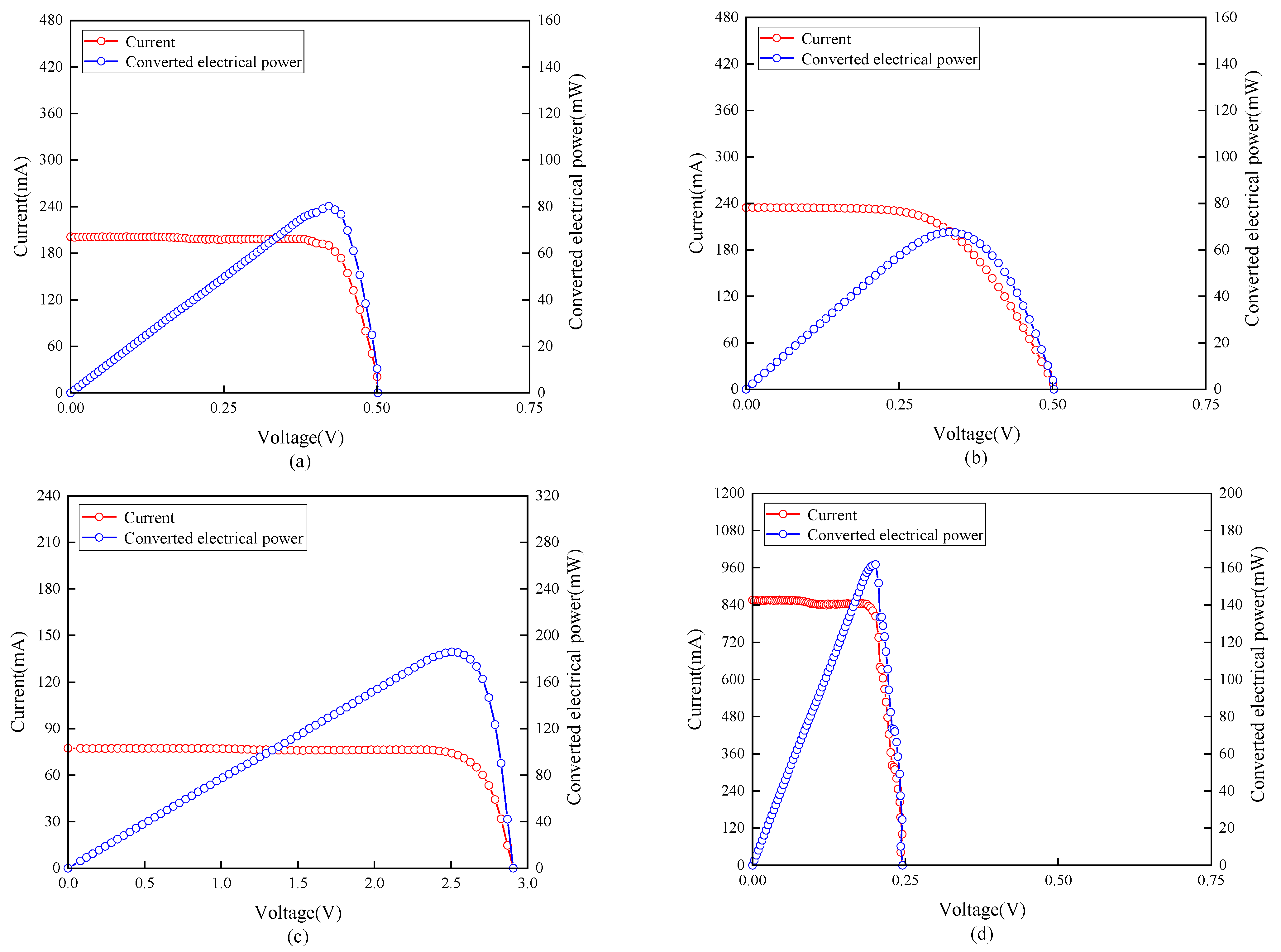
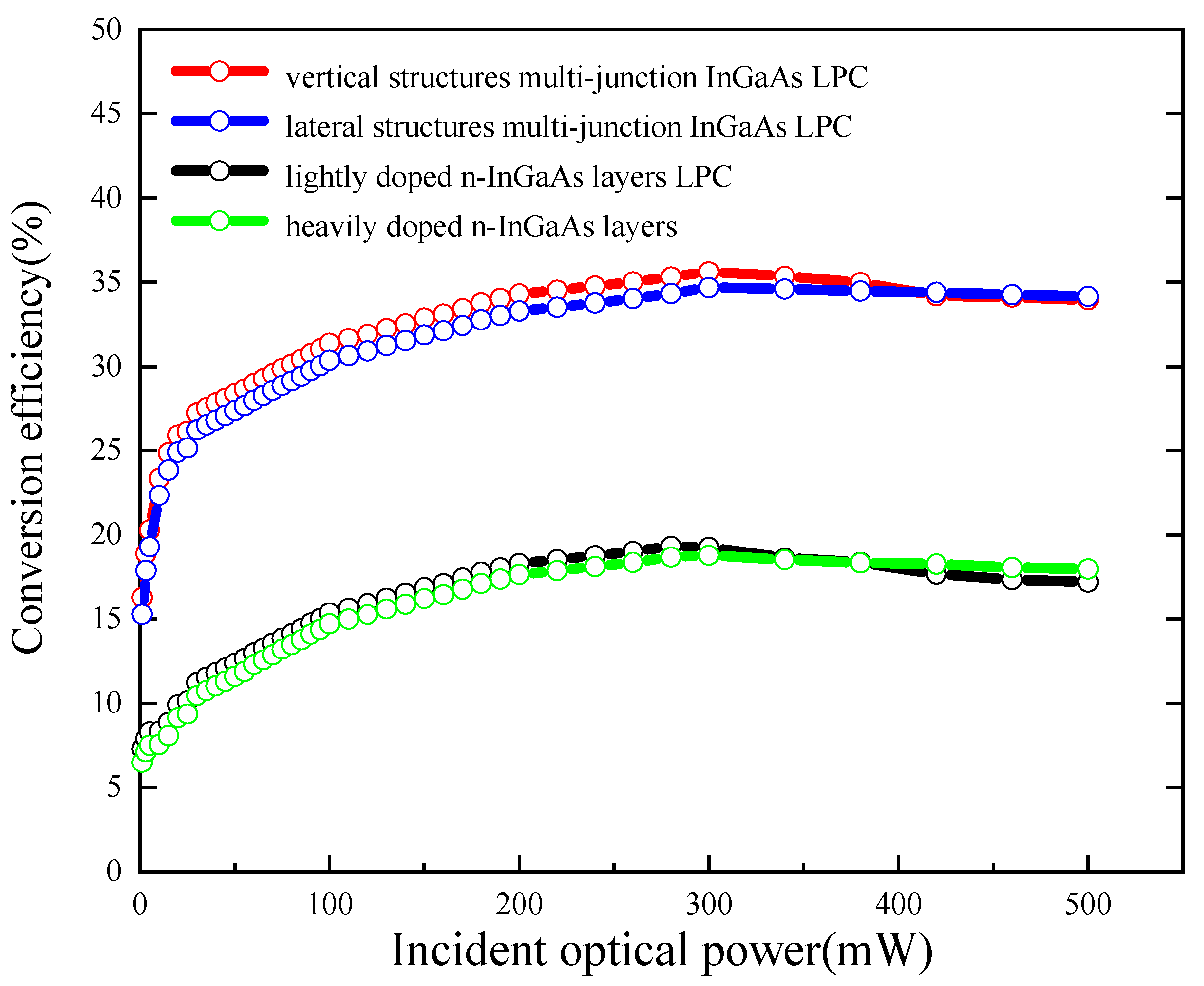
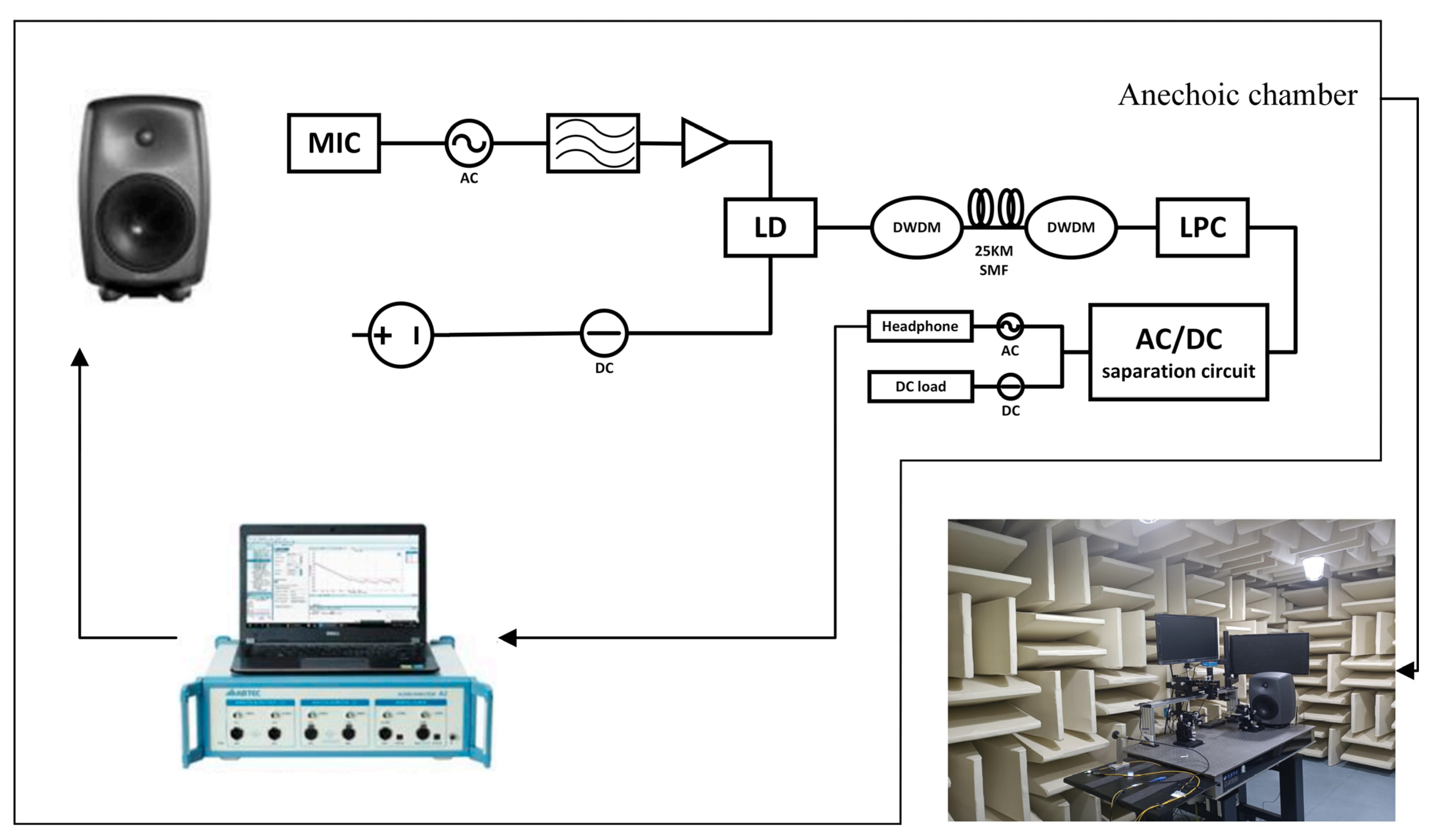
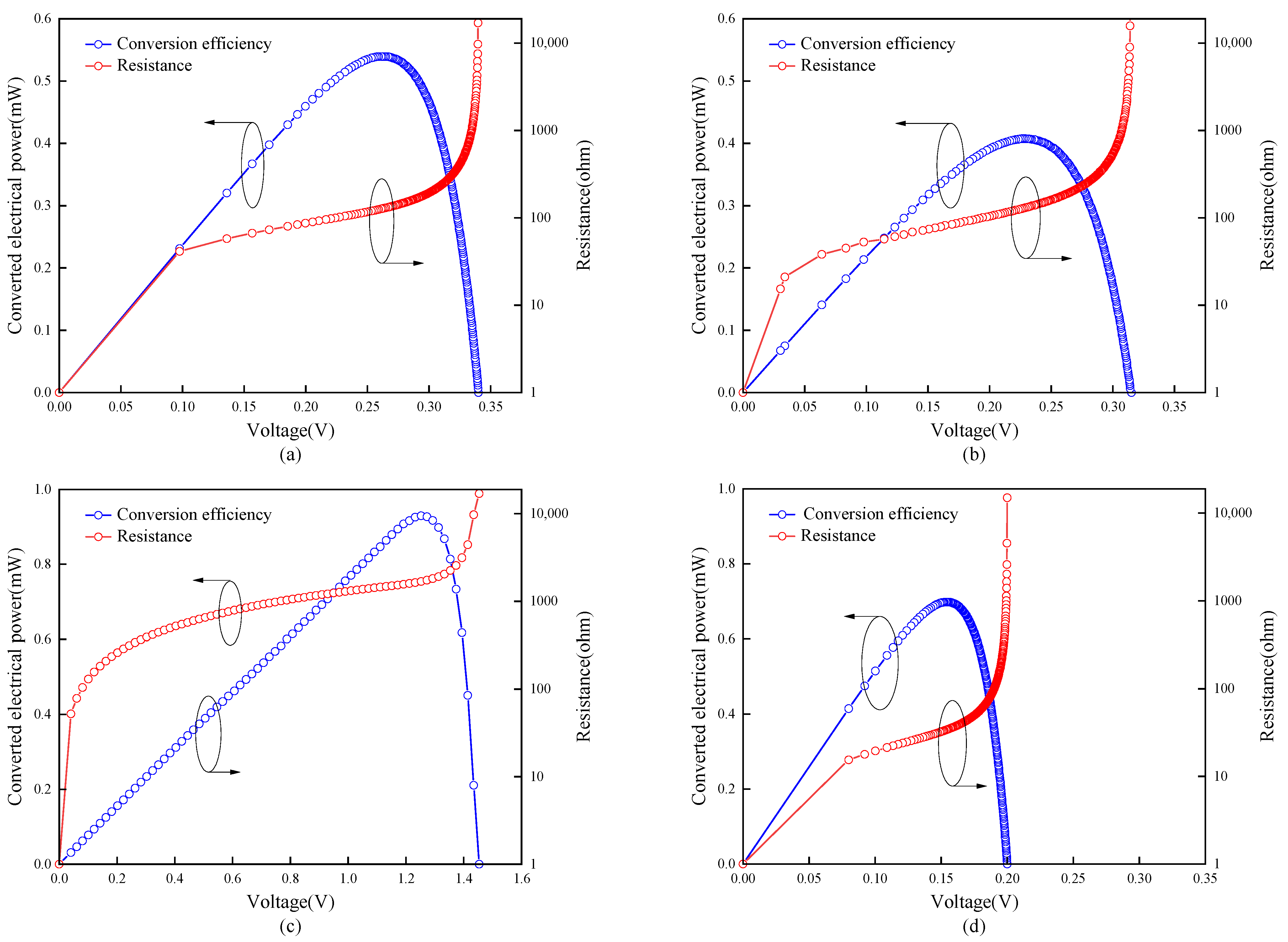

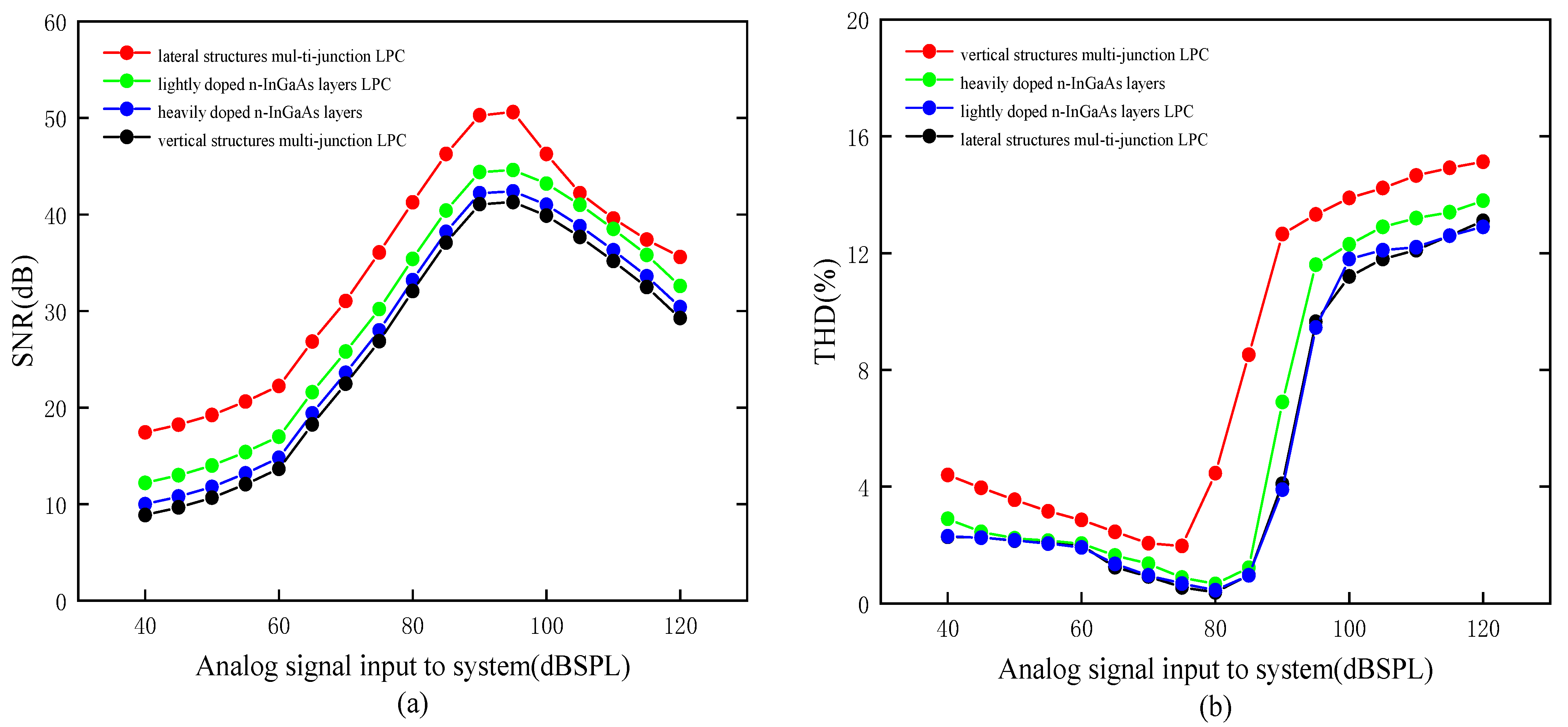

Disclaimer/Publisher’s Note: The statements, opinions and data contained in all publications are solely those of the individual author(s) and contributor(s) and not of MDPI and/or the editor(s). MDPI and/or the editor(s) disclaim responsibility for any injury to people or property resulting from any ideas, methods, instructions or products referred to in the content. |
© 2023 by the authors. Licensee MDPI, Basel, Switzerland. This article is an open access article distributed under the terms and conditions of the Creative Commons Attribution (CC BY) license (https://creativecommons.org/licenses/by/4.0/).
Share and Cite
Zhou, Y.; Guan, C.; Lv, H.; Zhang, Y.; Zhou, R.; Chu, W.; Lv, P.; Qin, H.; Li, S.; Li, X. Design and Research of Laser Power Converter (LPC) for Passive Optical Fiber Audio Transmission System Terminal. Photonics 2023, 10, 1257. https://doi.org/10.3390/photonics10111257
Zhou Y, Guan C, Lv H, Zhang Y, Zhou R, Chu W, Lv P, Qin H, Li S, Li X. Design and Research of Laser Power Converter (LPC) for Passive Optical Fiber Audio Transmission System Terminal. Photonics. 2023; 10(11):1257. https://doi.org/10.3390/photonics10111257
Chicago/Turabian StyleZhou, Yikai, Chenggang Guan, Hui Lv, Yihao Zhang, Ruling Zhou, Wenxiu Chu, Puchu Lv, Haixin Qin, Shasha Li, and Xiaoqiang Li. 2023. "Design and Research of Laser Power Converter (LPC) for Passive Optical Fiber Audio Transmission System Terminal" Photonics 10, no. 11: 1257. https://doi.org/10.3390/photonics10111257
APA StyleZhou, Y., Guan, C., Lv, H., Zhang, Y., Zhou, R., Chu, W., Lv, P., Qin, H., Li, S., & Li, X. (2023). Design and Research of Laser Power Converter (LPC) for Passive Optical Fiber Audio Transmission System Terminal. Photonics, 10(11), 1257. https://doi.org/10.3390/photonics10111257




